#Eastern Philosophy Influence
Explore tagged Tumblr posts
Text
“A high degree of intellect tends to make a man unsocial.”
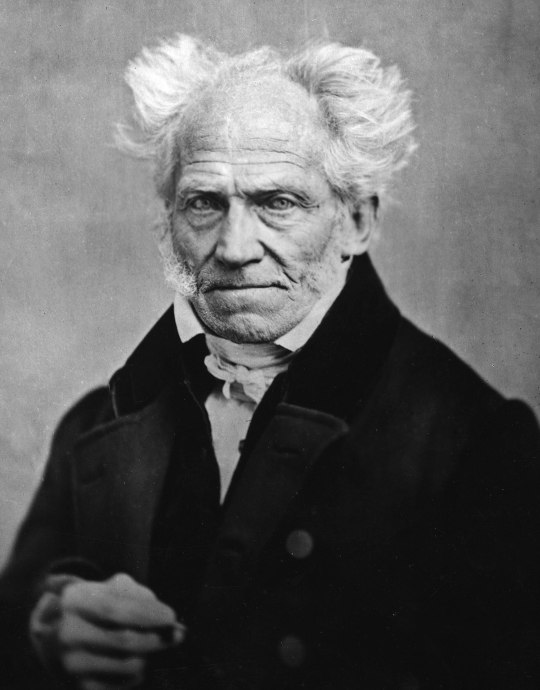
Arthur Schopenhauer was a German philosopher. He is best known for his 1818 work The World as Will and Representation.
#Pessimism#Will and Representation#Metaphysics#Ethics#Existentialism#Philosophy of Mind#Kantianism#Aesthetics#Solipsism#Nihilism#Idealism#Compassion#Individualism#World as Illusion#Transcendental Idealism#Suffering#The Fourfold Root of the Principle of Sufficient Reason#Eastern Philosophy Influence#Art and Beauty#Critique of Hegel's Philosophy#today on tumblr#quoteoftheday
30 notes
·
View notes
Text
Unveiling the African Essence in Eastern Philosophy
A Tribute during Black History MonthAs we embark on the celebration of Black History Month, it’s essential to recognize the myriad contributions of African descendants not just in shaping modern civilization but also in sculpting the contours of Eastern philosophy. The historical interweaving of African traditions with Eastern thought offers a rich narrative, highlighting a profound exchange of…

View On WordPress
#African influence#ancestral wisdom#ancient Egypt#Black History Month#Eastern Philosophy#Greek philosophy#Interconnectedness#nonduality#spiritual synergy#Transcendental Meditation#Ubuntu#Yoruba
10 notes
·
View notes
Text
1st division and 4th division are on the different end of a spectrum where the 1st focus on the individual strength, monster to fight monsters even if it mean to disregard of their own humanities while the 4th division will go out of their way to tell the soldier that they can't keep risking their life and sometimes it's okay to fall back. (Helped by their terrain having more wide-open mountain areas far from the central. I can see why 1 and 3 can't afford that amount of chill)
#fal's random thoughts#faltalkskn8#How to...gather my thoughts....#4 eastern divisions are directly influenced by Isao and the 1st is the most influenced#2 and 3 a bit less and 4 is the furthest#protrayal of 4th division is still limited and 2nd only have Jura's personality and Haruichi/Aoi post-training to go by#b-but...thinking of organization philosophy is so fun....#gotta dig my notes and relearn how to live again
3 notes
·
View notes
Text
i'm doing an x-files rewatch now and let me tell you... "all things" hits differently now at almost 43 than it did when i first watched it at 18. it's like it was specifically made for woo-believing, hippie, middle aged me. i was intrigued by it the first time i saw it and it became my favourite episode. it still holds up all these years later.
#the x-files#txf#mulder#scully#middle age#all things#all things was seriously underrated#loads of people didn't like it#i think it's because it was very cerebral#and very influenced by eastern philosophy#and written and directed by a woman#and scully-centric#and shows scully as morally grey in her past#it's one of the best episodes#it has stuck to me all these years
1 note
·
View note
Text
Writing Notes: Philosophy

Philosophy - aims to ascertain basic existentialist truths of the world around us.
The term comes from “philosophia,” a word that has Greek and Latin origins.
Philosophers examine the nature of reality by posing philosophical questions or problems that they then attempt to solve through critical thinking.
Branches of Philosophy
Much of the value of philosophy lies in the specialization and categorization of philosophical questions that cannot be easily answered with empirical data or scientific knowledge.
Scholars organize such questions into different branches of thought, although there are perhaps as many ways of categorizing the different branches as there are scholars.
Here are just 3 of the potentially dozens of branches of philosophy:
Epistemology: Also called the theory of knowledge, this analytic philosophy studies the scope, validity, and extent of human knowledge—in other words, concepts surrounding how we can confirm what we think we know is true. Immanuel Kant’s Critique of Pure Reason is an example of epistemology. In this work, Kant disagrees with philosopher David Hume, that our experiences and perceptions of things are subjective—therefore, our knowledge of things is not universal. Epistemology overlaps with many other branches of philosophy since human knowledge is relevant in other areas, such as the philosophy of language and the philosophy of mind.
Ethics: The moral philosophy of ethics is one of the oldest and broadest branches of philosophy. Ethics works to debate values of good and evil and questions where human actions fall on that spectrum. The ancient Greeks struggled with these questions as they developed their societies along two schools of thought—Stoicism and Epicureanism. Although these two schools, established in 300 BC, shared several tenets, they differed in describing the best way to live. Stoics believed that living a just and virtuous life was paramount, while Epicureans believed the search for pleasure should be the highest priority. Due to its broad nature, ethics is pervasive in nearly every academic discipline and overlaps within several other areas of thought, including the philosophy of history, the philosophy of law, and the philosophy of religion.
Metaphysics: The principles of metaphysics question our place in the world and the meaning of life and human existence. Metaphysics, like ethics, began as one of the main branches of philosophy in ancient Greece. One of the premier philosophical works that established the branch was Aristotle’s Physics. In exploring the working mechanics of our reality, Aristotle created foundations of thought that became important to western institutions and religions, like Christianity. Aristotle’s work greatly influenced the thirteenth-century Italian priest Thomas Aquinas, who utilized aspects of Aristotle’s philosophy of nature to confirm the existence of God as the omnipotent architect of the universe. Metaphysics often encompasses or overlaps with the philosophy of science—for example, as scientists grapple with questions related to humanity’s literal and figurative place in the universe.
Historical Figures of Eastern Philosophy
Learn how these notable eastern philosophers shaped their cultures with religion and philosophical breakthroughs throughout the history of philosophy:
Laozi (born circa 570 BCE): The historical existence of Laozi, or Lao Tzu, is disputed, but some believe the Chinese philosopher is the author of the Tao Te Ching, a manuscript central to the philosophical religion known as Daoism (or Taoism). The metaphysical and ethical philosophy promotes living in harmony with nature and doing no harm to others.
Confucius (551–479 BCE): The teachings of this Chinese philosopher and politician formulated the basic tenets of East Asian societies. Known as Confucianism, the Chinese philosophy encouraged family loyalty, ancestral appreciation, and education—concepts that remain important to modern Chinese traditions.
Siddhartha Gautama (born in fifth century BCE): Historians and academics dispute the facts of the life of Siddhartha Gautama, also known as the Buddha. By some traditions, he was born into an aristocratic family and enjoyed an entitled life until he decided to pursue a nomadic and ascetic lifestyle. Over time, people attributed teachings to him on self-restraint, meditation, and mindfulness—ideas that grew into a popular world religion.
Jalāl ad-Dīn Mohammad Rūmī (1207–1273): A thirteenth-century Persian poet, Jalāl ad-Dīn Mohammad Rūmī wrote Quranic verses and Sufi poems that scholars still translate and publish today. A large part of philosophy in Rumi’s poetry is his set of values around love and religion. His philosophy of life focused on using art and self-expression to bring humans closer to God.
Historical Figures of Western Philosophy
Ancient Greek philosophers established western philosophy as early as the sixth century BCE. Here are a handful of Greek philosophy figures who created theoretical foundations and frameworks that future generations could use to question their own complex societies:
Socrates (470–399 BCE): The Athenian philosopher Socrates is credited as the founding father of western philosophy and the Socratic method—a form of questioning that scholars in multiple areas of philosophy use to pinpoint shortcomings in logic or beliefs. His teachings were never published but lived on through the work of his student, Plato.
Plato (428/427–348/347 BCE): An influential thinker of the classical Greek period, Plato is famous for his theory of forms, which questions the connection between our minds and reality. He is also remembered for his several published works, like The Republic, which communicated his social and political philosophy.
Aristotle (384–322 BCE): The philosopher Aristotle was a star pupil of Plato’s (another ancient philosopher) and went on to found his own school, called Lyceum. During his career, Aristotle collected and simplified the philosophies of his predecessors and contributed to philosophical work in nearly every aspect of classical Greek culture. He was the first ancient philosopher to analyze the concept of free will.
René Descartes (1596–1650): A French mathematician and philosopher, René Descartes is best known for the existentialism theories he put forth in Discourse on the Method and his statement: “I think, therefore I am.” Descartes’ natural philosophy and metaphysical inquiries, as well as his thoughts on the existence of God, established him as a pioneer of modern philosophy.
Georg Wilhelm Friedrich Hegel (1770–1831): German philosopher Georg Hegel is best known for his metaphysical concept known as idealism. The concept dictates that the perceptions of a self-conscious mind result in the most accurate interpretations of concrete objects. His work had a dramatic impact on western philosophy in the twentieth century and influenced the works of philosophers Karl Marx and Friedrich Nietzsche.
Source ⚜ More: Notes & References ⚜ Writing Resources PDFs
#philosophy#writing notes#studyblr#writeblr#dark academia#writing reference#writing inspiration#worldbuilding#literature#writers on tumblr#writing prompt#spilled ink#history#creative writing#writing ideas#light academia#ivan kramskoy#writing resources
126 notes
·
View notes
Text
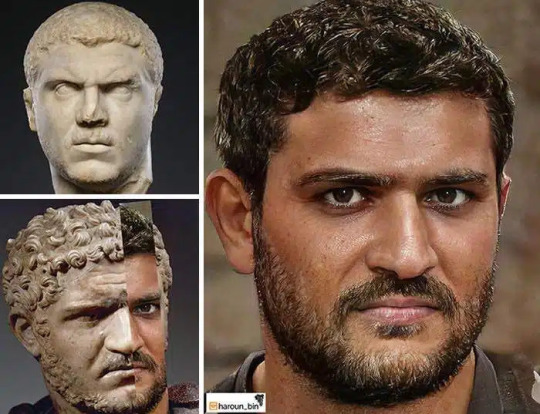
The enigmatic emperor Caracalla. Lucius Septimius Bassianus, renamed Marcus Aurelius Antoninus at age 7, was born on April 4, 188 in Lugdunum, Gaul (Lyon, France). Like 'Caligula', he's known by a nickname rather than his name.
His father, Septimius Severus, became the first Roman emperor of North African origin in 192; His mother, Julia Domna, was a noble lady of Arab origin born in Emesa (Homs, Syria)
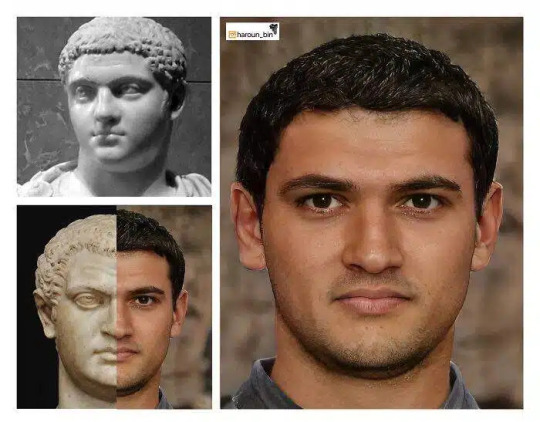
Publius Septimius Geta was born in Rome, 11 months after his brother 'Caracalla'. All historical sources claim that they never had a brotherly relationship. According to historians, Geta was more appreciated by the Senate and the people than his brother. Herodian wrote that they constantly fought for any reason and "it was impossible to hide the rivalry between the brothers, although the emperor Septimius tried in vain to keep this from being known".
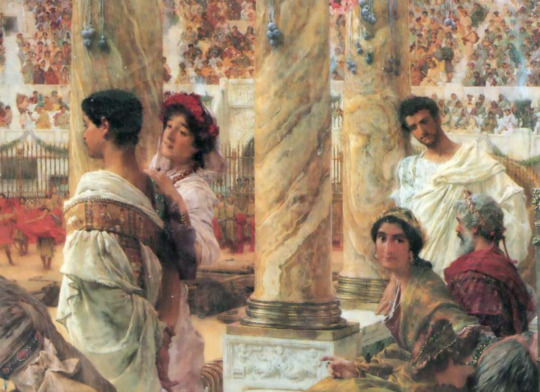
"Geta and Caracalla" by Sir Lawrence Alma Tadema (detail). In this painting the Emperor Septimius and the Empress Julia Domna are shown seated. Geta is standing next to a woman, and Caracalla is pensive by a column; the painter depicts him as sad - perhaps jealous - of his brother's popularity.
An unusual empress
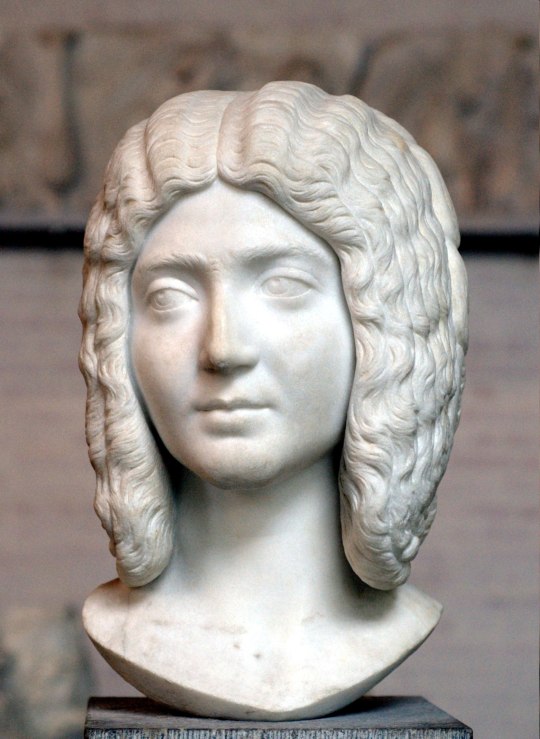

Busts of Julia Domna. Photos :Bibi Saint-Pol, and Daderot (CC)
Julia Domna always accompanied her husband in all the campaigns, the reign of Septimius Severus was extremely militarized. She received the title Mater Castrorum (Mother of the legionary camps). She made political decisions directly, something unprecedented in Rome for a woman. After the death of Septimius, Julia Domna was granted the titles: Mater Senatus and Mater Patriae (Mother of the Senate, Mother of the Nation). She was a scholar in Philosophy, and had a notable influence on that subject. She was involved in several architectural projects including the famous Caracalla Baths, enormous work planning by her husband and completed by her son. She was highly respected by the Senate throughout her reign (192-217).
"Let there be peace among you both, pay the army well and forget the rest". -Septimius Severus to his children on his deathbed

'Geta Dying in his Mother's Arms' by Jacques Pajou.
Britannia, February 4, 211: Septimius died of natural causes, accompanied by his family. Caracalla and Geta, aged 22 and 21, had been emperors with their father since childhood, but after the death of Septimius, as expected, such co-government would not last long.
According to contemporary historian of that period, Herodian : "The co-emperors constantly quarreled and feared that one of them would poison the other, so they did not eat at the same table."
Rome, December 27, 211: 'Caracalla' ordered the execution of Geta, claiming to have discovered that his brother was plotting to assassinate him. The execution carried out by two centurions was in the presence of Julia Domna. According to contemporary sources, Caracalla had tried to kill Geta a few days earlier, during the Saturnalia festival.
Following Geta death he ordered the execution of all Geta's supporters, among them Lucius Aurelius, the only grandson of Marcus Aurelius, son of Lucilla and Pompeianus.
The curious thing is that empress didn't leave her son Caracalla; This caused the Empress to lose popularity among the people, especially in the eastern provinces where, according to historians, Geta was very popular.
If you were born in Roman territory so you're a Roman.

In 212 he issued the Constitutio Antoniniana, also known as the Edict of Caracalla, which granted Roman citizenship to every free men and women living in Roman territory - although by then Roman citizenship had increased significantly throughout the empire - and from then on every free child born in the Empire was a Roman. This was criticised by contemporary historians but modern historians agree that he understood what certain elitist people in the city of Rome refused to understand. 'Caracalla' was Emperor of Rome but he was of Punic and Arab origin and born in Gaul; he was living proof that the city of Rome was the capital of a multi-ethnic world.
An awesome site



Baths of Caracalla. Reconstruction made by team of 'History in 3D'
The Caldarium (sauna) was built in the Pantheon style and the vestibule was in basilica style; Just two simple parts of a baths building were something magnificent in themselves. It was an immense complex that, in addition to the typical cold, warm, and hot baths, dressing room, massage and beauty salons, included two libraries, gym, impressive swimming pools, a stadium , vast gardens, a small museum with exhibitions of works of art, and a shopping center with a wide variety of businesses.
The Alexandria Massacre

'Caracalla' by Sir Lawrence Alma Tadema
After a trip through the eastern provinces, in December 215 he arrived in Alexandria. The Alexandrians, outraged by the death of emperor Geta, began to public perform plays of satire mocking Caracalla and in which they called empress mother "Jocasta." According to the famous legend, Jocasta was the mother of Oedipus who, after killing his father, had married his own mother. Upon discovering this his wrath was such that ordered a massive executions. Caracalla attacked the city with his troops for several days, in a kind of personal war against Alexandria.
Unexpected death
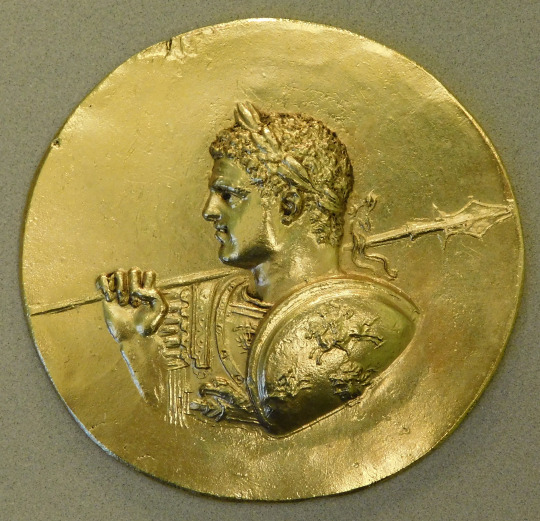
Gold medal bust of Caracalla with the shield of Alexander the Great. By Sailko /CC BY 3.0 /wikimedia commons.
In 216 he offered King Artabanus IV of Parthia to marry his daughter, but the king rejected the offer. Caracalla took advantage of this "snub" to start a campaign against the Parthian empire. He began attacking the countryside east of the Tigris. This sudden decision by Caracalla was surprising and shocking at the time, as it was the first time in a century that a Roman emperor had led his troops toward expansionist purposes. According to historians, Caracalla had an obsessive admiration for Alexander the Great and wanted to emulate him by following his route.
In early 217 he was in Edessa (modern Şanlıurfa,Turkey) preparing to restart the campaign.
On April 8, 217, four days after his 29th birthday, he was traveling to a temple near Carras (Harran, southern Turkey) and the praetorian soldier Martialis assassinated him with his sword. According to historical sources, the Prefect of the Praetorian Guard, Macrinus commissioned him to assassination. Martialis was executed immediately after Caracalla's death, and three days later Macrinus proclaimed himself emperor.
Empress Julia Domna was in Antioch, upon learning of the assassination decided to take her own life.
This seems like the end of The Severan dynasty, however it wasn't. Julia Maesa, older sister of Julia Domna, was a strong lady.
In her hometown, Emessa, where Macrino had forced her to return, she took advantage of the fact that it was a place with an important military base. She organized with the legions a war against the usurper Macrinus. She placed his grandson Elagabalus on the throne on May of 218. Macrinus, who had fled to Cappadocia, was executed two months later. After the death of Elagabalus, the other grandson of Julia Maesa, Alexander Severus, ruled until 235.
"I know that none of you like what I do, that's why I have weapons and troops: so that at no time do I have to worry about what you say about me." -Caracalla to the Senate

Emperor Caracalla. Marble. Acquired from Rome, Italy, in 1875. Altes Museum, Berlin. Photo: Osama Shukir Muhammed Amin FRCP (Glasg) CC BY-SA 4.0- Wikimedia Commons
He is known as 'Caracalla' because that is what the Romans called a Gallic garment with a hood that they say this emperor didn't take off even to sleep.
#roman empire#history#severan dynasty#roman emperors#ancient rome#oil painting#oil on canvas#painting
379 notes
·
View notes
Note
I understand that Psychopomp was born out of necessity due to the policies put in place by Unity, but alot of the story and designs for environments and characters are incredibly thought out. Were these ideas retooled from previously scrapped projects or ones you worked on before the Unity debacle (Mechana/Dreamwild)? What are your influences on some of the more esoteric concepts/mystical oddities within the stories of your games? Also, why is the moon's design one of the main unifying factors in your games? (Atleast that i know of, I only played Dashbored, Dreamwild, and Psychopomp.)
I had the idea for Psychopomp a few months before the Unity policy debacle, so when that all happened, it ended up being more of an opportunity to revisit that character and idea again (though at that point it was really just the one character design and the idea of the helmet)
For the most part, the ideas from Psychopomp weren't borrowed from my other games. There are a few however. In the 2014 early development version of DashBored (Then called "Drive") the second level was a factory run by a giant severed head. You would have to mercy kill the head to continue on. This was removed pretty quickly from the game, but I wanted to revisit it, because it made one of my highschool friends really uncomfortable. The head came back ten years later for Psychopomp, and the design is even taken from Drive.

(The old sprites. I didn't really know how to make digital art at this point)
The King of Mercury and King of all Dogs were originally from an idea for a separate video game. However, I really liked them, and I didn't want to wait to have to wait for years to be able to potentially make something with them in it, so I worked them into the story of Psychopomp.

(The original drawings that would become the King of all Dogs and King of Mercury. The King of All Dogs inner face here is inspired by traditional Haida art. This influence was dropped for Psychopomp because it didn't fit the grimy artstyle, but I'd like to bring it back in the future.)
I grew up in a household surrounded by a lot of spiritualism and various eastern philosophies. A lot of my youth was spent in spiritual shops and various shrines of different denominations. I ended up with a lot of esoteric concepts in my head and came to really appreciate a lot of the various spiritual aesthetics of the world. It's hard to come to terms with a world that's brimming with so many concepts, many of which contradict and attack each other, and that spiritual anxiety makes up a lot of my feelings in Psychopomp.
As for the moon, all I can say is: Note who it appears to, and when and where it appears. The moon is watching.
Thanks for the ask! This is a really great question! I hope you enjoyed the games, and I hope you'll enjoy what I have in store for the future!
150 notes
·
View notes
Text

Why Non-Black People Fear Black Self-Help—and Why Black People Shouldn’t Care (A Garveyite Perspective)
From a Garveyite lens, rooted in the teachings of Marcus Garvey and Pan-Africanism, Black self-determination is not just a goal—it’s a necessity. Yet, throughout history, efforts by Black people to uplift and empower themselves have often been met with resistance, fear, and concern from non-Black groups. Why is this the case? And why, according to Garveyite philosophy, should Black people not concern themselves with these reactions?
Let’s break it down by demographic and dive into the root of these issues.
White People: Fear of Losing Power
Why They Fear Black Self-Help
1. Economic Dependency
The transatlantic slave trade, Jim Crow laws, and even modern capitalism have relied on Black labour and consumption to sustain white wealth. Black self-reliance disrupts these economic structures.
2. Challenge to White Supremacy
White supremacy thrives on the narrative of Black inferiority. When Black people organize and thrive independently, it threatens the foundation of this ideology.
3. Fear of Retaliation
Centuries of systemic oppression create a lingering fear that an empowered Black population may seek revenge or disrupt white-dominated institutions.
4. Guilt and Accountability
Black self-help forces white people to confront their role in historic and systemic oppression, creating discomfort and resistance.
Garveyite Response
Marcus Garvey famously said, “The Negro must be self-reliant.” White feelings are irrelevant when the goal is freedom. Black people cannot wait for white approval to act in their own best interests.
Asian Communities: Fear of Economic Disruption
Why They Fear Black Self-Help
1. Economic Competition
Many Asian immigrant businesses (e.g, Inidan/ Korean-owned beauty supply stores) profit from Black neighborhoods without reinvesting in them. Black-owned businesses threaten this status quo.
2. The "Model Minority" Myth
Anti-Blackness is baked into the "model minority" narrative, which positions Asians as "successful" by proximity to whiteness. Black empowerment disrupts this racial hierarchy.
3. Cultural Distance
Due to historical anti-Black stereotypes and a lack of solidarity, some Asian communities may view Black independence with scepticism or fear.
Garveyite Response
Garvey taught that “no one knows when the hour of Africa’s redemption cometh.” Black people must focus on rebuilding their communities without worrying about disrupting anyone else’s economic or cultural comfort.
Hispanic/Latino Communities: Fear of Marginalization
Why They Fear Black Self-Help
1. Resource Competition
Hispanic/Latino and Black communities often occupy the same socio-economic space. Black self-help is seen as competing for limited resources like housing, jobs, or political influence.
2. Internalized Anti-Blackness
Colonial histories of colourism and caste systems perpetuate anti-Black sentiment within Latino cultures, leading to mistrust of Black movements.
3. Political Power Dynamics
As Latino populations grow, there’s a fear that Black empowerment movements might outpace their own political or social progress.
Garveyite Response
Black people’s struggles and liberation are unique and cannot be conflated with others’. The focus must remain on the upliftment of the Black race without being derailed by concerns over perceived competition.
Arab and Middle Eastern Communities: Fear of Losing Economic Footing
Why They Fear Black Self-Help
1. Economic Dependence on Black Communities
Arab-owned corner stores and gas stations often dominate Black neighbourhoods. Black-owned businesses threaten this dynamic.
2. Anti-Black Cultural Attitudes
Some Arab cultures perpetuate anti-Blackness, often rooted in histories of the trans-Saharan slave trade and colonial racism. Black empowerment challenges these biases.
Garveyite Response
Garvey’s teachings remind us that no group has the right to profit off Black labour and communities without reciprocation. Black people must reclaim ownership of their economies, regardless of the discomfort it causes others.
Other oppressed Communities: Tensions Over Shared Struggles
Why They Fear Black Self-Help
1. Competing Oppression Narratives
Black and other oppressed people have faced colonial oppression, but there’s a fear that Black self-help movements might overshadow these oppressed people's struggles.
Garveyite Response
While solidarity with other oppressed groups is important, Garveyite philosophy emphasizes that Black liberation must come first. Black people can not carry the weight of others’ struggles while fighting their own.
The Bigger Picture: Why These Fears Exist
Across all demographics, the resistance to Black self-help stems from:
Economic Dependency: Many groups rely on Black labour and consumption.
White Supremacy: Anti-Blackness is a unifying force in global racial hierarchies.
Fear of Change: An empowered Black population threatens existing systems of privilege and oppression.
Why Black People Shouldn’t Care
1. Liberation Is Non-Negotiable
Garvey said it best: “Up, you mighty race, accomplish what you will.” Black liberation can not be compromised to appease the fears or discomfort of others.
2. Others Have Always Prioritized Themselves
No other group pauses their progress to accommodate Black people. It’s time for Black communities to unapologetically focus on themselves.
3. Historical Proof of Success
Movements like the UNIA, Black Wall Street, and Pan-Africanism have shown that Black self-reliance works—despite resistance from others.
4. White Supremacy Is the Root Cause
Many of these fears are rooted in white supremacy, which pits marginalized groups against one another. Black people must dismantle this system by prioritizing their own empowerment.
5. Self-Determination Is a Human Right
Every group has the right to organize for its own survival and success. Black people are no exception.
Conclusion
Black self-help and self-determination will always provoke fear and resistance from those who benefit from the current power dynamics. From a Garveyite perspective, these concerns are irrelevant. Black people must prioritize their own liberation, unity, and empowerment without apology.
As Garvey proclaimed, “Africa for the Africans, at home and abroad.” Let the discomfort of others be a testament to the power of Black progress. Stay focused, stay unified, and keep moving forward.
#black people#black history#black#black tumblr#blacktumblr#pan africanism#black conscious#africa#self empowerment#self determination#marcus garvey#black power#black empowering#black liberation#racial justice#people of color
85 notes
·
View notes
Text
Philosophy Regarding Antiship Logic
( !! PLEASE READ !! This is my person belief and idea that I wanted to share. Please respect it! I'm always up to have a friendly chat but please don't be rude. Thank you!) I've been reflecting on modern philosophy and its influence on contemporary fandom culture, particularly the discourse between "proship" and "antiship" communities. I believe I have reached a compelling conclusion regarding the moral foundations of this debate.
To begin, let us define "antiship." The term generally refers to fans who disapprove of certain fictional ships and their supporters on the grounds that these relationships are problematic or morally objectionable. However, this raises a fundamental question: What constitutes moral wrongdoing?
This is where the antiship argument begins to unravel. The phenomenon of antishipping is primarily observed in Western society or within fandom spaces heavily influenced by Western social norms, whereas Eastern fandom cultures exhibit a relative lack of such discourse. This discrepancy suggests that the moral framework underlying antishipping is not universal but rather culturally contingent.
Drawing from the work of Friedrich Nietzsche, we can further deconstruct this issue. Nietzsche critiqued the origins of morality, particularly its foundation in Judeo-Christian teachings. If we accept his argument that morality is not an absolute truth but a construct shaped by historical and religious influences, then the moral objections posed by antishippers become questionable. How can one claim that a particular ship is "immoral" if the very concept of morality is rooted in millennia-old doctrines that are not universally accepted?
Furthermore, within the antiship community itself, there exists ongoing contention over which beliefs or ethical stances are "more morally right." This internal conflict highlights a broader philosophical issue: If morality is not an objective truth but a subjective construct, then no single moral stance can be definitively proven superior to another.
Additionally, one could argue that antishippers’ beliefs regarding the morality of certain ships could, in some cases, be interpreted as racially or culturally insensitive, if not outright xenophobic. There have been instances in which antishippers have engaged in such behavior, particularly when moral judgments about shipping are imposed upon works from cultures with different ethical and historical backgrounds. By applying a Western moral framework to media originating from non-Western cultures, antishippers risk reinforcing ethnocentric biases and disregarding cultural contexts that do not conform to their own moral perspectives.
Ultimately, the purpose of this argument is to illustrate that the antiship perspective lacks a stable foundation. Concepts of "right" and "good" are not objective realities but rather socially and historically contingent ideas. Thus, moral condemnation within fandom spaces is inherently flawed, as it relies on a framework that is neither universal nor absolute.
#antis do not interact#fandom culture#fandom etiquette#fandom psychology#proshipper safe#purity culture#philosophy#friedrich nietzsche#nietzche
71 notes
·
View notes
Note
If the Dusk Court still existed alongside the other courts, what do you think it would look like? As well as its clothing and architecture. What would you want its culture to be like and what language do you think they would have?
If the Dusk Court still existed alongside the other courts, I imagine it as one of the most culturally profound and symbolically layered courts—the bridge between light and dark, life and death, change and permanence.
The Dusk Court — The Realm of Twilight and Transcendence
Dusk is neither day nor night—it’s a threshold, a liminal space. I see the Dusk Court as a place that thrives on balance, introspection, and reverence for the in-between. It’s a society that embraces ambiguity, transformation, and cyclical patterns—where nothing is static, and every ending is honored as a beginning.
1. Architecture: Inspired by Ancient Petra, Moroccan Riads, and Byzantine Influence
I picture the Dusk Court as a city carved into nature itself, much like Petra in Jordan—rose-stone facades, seamlessly blending into cliffs and canyons. The structures wouldn’t dominate the landscape, but emerge from it, reflecting the Court’s philosophy of harmony and transience.
From Moroccan architecture, I’d borrow the idea of hidden beauty—plain exteriors that open into stunning inner courtyards (riads) filled with fountains, tiled mosaics, and shaded gardens. Privacy and inner reflection would be key values, so homes and public buildings would focus inward, designed for contemplation and peace.
The spiritual heart of the court could resemble Byzantine basilicas, with grand domes, intricate mosaics of twilight skies, and soft light filtering through stained glass in muted golds, purples, and blues. The Hagia Sophia comes to mind—an architectural testament to both earthly grandeur and spiritual transcendence.
Key Features:
Sandstone cities glowing at sunset.
Reflective pools and labyrinthine streets, symbolizing life’s winding paths.
Open-air temples honoring celestial cycles, with no roofs to separate them from the skies.
Use of geometric patterns, similar to Islamic art, representing the infinite and unknowable.
2. Clothing: Rooted in Desert Cultures, Byzantine Luxury, and Japanese Minimalism
The Dusk Court’s fashion would blend practicality with philosophical symbolism.
Inspired by North African and Middle Eastern garments, they’d wear flowing robes and light, breathable fabrics—perfect for climates where days are hot and nights are cool. Think djellabas, kaftans, and abayas layered in soft gradients, echoing the shifting colors of twilight.
From Byzantine culture, I’d imagine intricate embroidery—threaded in gold and silver—depicting cosmic motifs: setting suns, crescent moons, stars, and cyclical patterns.
But there would also be a hint of Japanese aesthetics—a respect for simplicity, impermanence, and nature. Perhaps elements of wabi-sabi, where beauty is found in imperfection and age. Faded fabrics, hand-stitched repairs (like boro), and heirloom garments passed through generations would be common.
Color Palette:
Muted violets, soft ochres, deep indigos, dusty rose, and shimmering golds—colors that shift depending on light, embodying the transient beauty of dusk.
3. Culture: A Society of Philosophers, Mystics, and Keepers of Balance
The Dusk Court would be deeply philosophical—drawing from traditions like:
Taoism: The belief in balance and the flow of natural forces (yin and yang). They’d reject extremes, favoring harmony and the acceptance of life’s dualities.
Sufi Mysticism: A culture of poetry, dance, and music as forms of spiritual expression. Imagine whirling dervish-like rituals, where movement becomes a meditation on the cycles of life.
Ancient Egyptian View of Ma’at: The concept of cosmic balance, truth, and order. The Dusk Court might view themselves as guardians of Prythian’s metaphysical equilibrium, ensuring no court tips too far into chaos or tyranny.
Mesoamerican Calendar Culture: A deep reverence for time and celestial events. Festivals would align with equinoxes, solstices, and rare astronomical phenomena. Every citizen would know their place within cycles of renewal and decay.
They would embrace mortality—not fearing death, but seeing it as a sacred passage. Funeral rites would be grand, but not mournful—celebrations of completion.
4. Language: A Blend of Arabic Poetics, Sanskrit Philosophy, and Indigenous Symbolism
The Dusk Court’s language would be highly metaphorical, designed to convey layers of meaning in few words—similar to how Arabic or Persian poetry can express vast emotional landscapes through symbolism.
They might have untranslatable words akin to:
“Tarab” (Arabic): The ecstasy from music.
“Saudade” (Portuguese): A longing for something lost.
“Ikigai” (Japanese): A reason for being.
Like Sanskrit, their language could be tied to philosophy and ritual, with precise words for spiritual concepts and cosmic forces. Perhaps they use pictographs or glyphs in writing, resembling Mayan or Egyptian scripts, where a single symbol encapsulates complex ideas.
Communication wouldn’t be rushed—silence could be as important as speech.
5. Political & Economic Structure: The Court of Mediators and Memory
Politically, the Dusk Court would serve as Prythian’s neutral heart. A place where courts send emissaries to settle disputes, guided by ancient laws older than any High Lord.
Leadership might not be a singular ruler but a council of elders—chosen not for power but for wisdom and life experience. Perhaps titles aren’t inherited but earned through deeds reflecting balance, insight, and service to the community.
Economically, they’d thrive on:
Artisan goods: Glasswork that captures twilight, enchanted scrolls, and twilight-blooming plants used in rare potions.
Knowledge trade: Selling maps of ancient ley lines, star charts, and philosophical treaties prized by scholars of other courts.
Hosting diplomatic summits and neutral trade agreements.
Final Thoughts:
If the Dusk Court still existed, it would be the soul of Prythian—not the most powerful, not the richest, but the wisest. A court that understands that strength isn’t just about armies or magic, but about knowing when to let go, when to endure, and when to stand as the quiet force holding everything together.
It would draw from cultures that value introspection, balance, and spiritual depth.
#anti acosf#anti inner circle#anti acotar#anti rhysand#anti feysand#anti cassian#anti azriel#anti amren#anti morrigan#anti nessian#anti night court
40 notes
·
View notes
Text

Working with Irene is a dream come true! Now Igor on the other hand... talk about a nightmare...!
This is it folks, the last of the Golden School teachers! We still have some other Eternals left to go, as well as the humans, but I feel like this is a good milestone to start the year with. Now, Irene and Igor are very particular: they only show up in what the fandom refers to as the "Russian saga", a self-contained story based on the show where Raf, Sulfus and friends briefly go to Russia for some lessons under these two. This context informed my design choices a lot, and they go as follows:
I chose Irene and Igor to be in charge of the Oneiric Compositing faculty, that is, dream-crafting. The concept came from Uriè's digi-dream camera: I thought it would be interesting if angels and devils also influenced humans in their sleep by either inspiring goodness or tormenting with fear respectively.
Irene's canon dress threw me off a bit: I could tell it was a Russian noblewoman's dress thanks to all the gold embroidery and red fabric, but I couldn't pinpoint its exact influence other than it was not a common sarafan. I scrapped the nobility aspect in favor of something more homely, inspired by traditional Eastern European clothes and the Matrioska doll (sorry, no detailed embroidery, I have to respect the design philosophy I've kept so far).
I chose the Matrioska doll as my key inspiration to homage the Russian saga, but also because of its ample symbolism. Some believe these dolls grant wishes and bring good omens; others find them to represent the layers of the mind and the self; they can also be seen as a mother figure, a symbol that embraces and protects generations to come. There's so many ways to look at Matrioska dolls and interpret them, just like dreams!
Igor also had to depart from his canon counterpart: I could tell the original design was inspired by Rasputin, and I see how his infamous reputation could enrich a devil character, but that same infamy could be brought into the picture in other ways. I kept the body complexion, the beard and the long coat as key elements so he would still be recognizable, but I fully departed from the real historical figure and instead focused on making him look like a nightmare that instilled fear and terror.
When I think "nightmare", I think boogeyman, bugbear, Krampus. A spindly, crooked old man that uses his walking cane to punish more than he does for walking, who will stuff you in a sack and take you away if you misbehave, his glowing eyes being the last thing you see before everything goes dark... His only mercy comes from his victims shuffling in the bag, thus ringing the bells tied on top, so now the other children know to beware! >:D
Irene's colors are the traditional primary colors: red, yellow and blue; red and yellow are warm colors and are naturally very eye-catching, so for contrast I used more shades of desaturated blue in her design. Her design is very curvy and full of semicircles, which inspired her halo's shape.
Igor instead has the traditional secondary colors: green, purple and orange; since green is very versatile in terms of warmth and coldness, I used it to highlight certain elements while keeping the rest of the palette more muted and dark (thus the orange became brown). His ram horns are very angular like the rest of his design, and they're the biggest devil horns yet, signifying his age.
If math serves me right I'm only missing three more Eternal designs for the central cast of characters (if you guess correctly which ones, you earn a cookie), but then again I was never great with numbers so I might surprise even myself down the line, hehe. We're done with the Golden School staff! Huzzah! :D
I'll Fly With You (rewrite fic) Art Masterpost
62 notes
·
View notes
Text

Thinking about a Natsuhi-Beatrice concept. Some assorted notes under the cut
One of my hcs is that all the witches are the age when their irl counterparts "gave up". Beatrice is 19 because that's when Sayo decided for sure to commit the massacre, Eva-Beatrice is in middle school because that's when Eva gave up on becoming the family head, and so Natsutrice is 15, mentally stuck in her wedding day when she realized she would not longer be Natsuhi, but a borrowed womb and wife for the Ushiromiya family's successor and not much else
Her outfit is based off 1950s Italian wedding dresses with elements of Lolita fashion (the layers and roses, mostly) but also tinged with red both to show her sins as well as her Shinto background (red features on many shinto wedding kimonos underneath the white). I specifically wanted to have the darkest red on her hands (representing the whole baby cliff thing), her innermost layer of clothing around her legs (fertility issues / womanhood related trauma) and the trail of her dress (always dragging the past forward). Because blood is used as a representation for sin, I wanted to use the red to show both Natsuhi's own actions / philosophies as well as mix it through the western and eastern influences on this design to call back to the ideas of forced assimilation and conquest that Natsuhi represents within the broader narrative. Also bc it looks cool
As for how she would actually act within the narrative I have not thought about that much, but I think because of her obsession with cleanliness and her constantly requesting to cover the deceased's faces during the Episodes there would be at least some aspect of Shinto funeral customs involved. I like to think all the bodies would be laying down + facing north, their faces covered and with piles of salt by the door instead of the magic circles. It's less gory, but deeply unsettling either way
132 notes
·
View notes
Text
Hexquad Cambridge University AU! Moodboards/Headcanons ✨️

A/N: A fun Au, but I'm too lazy to write it so instead I made some moodboards for each of the four pookies and some headcanons. 🎓🏫

Viktor, 26, an honourable Eastern European mix (Czech/Polish mom, Serb/Bulgarian dad)
Position: PhD in Applied Mathematics and Theoretical Physics, minor in Philosophy
Last name too difficult for Westerns to pronounce, so he is known simply as Viktor with a k at the university
He has been a prodigy since he was a child, winning innovator competitions left, right and centre
The State supported his education up until university. When his scholarship got rejected, his long-term tutor, the Dean of the Physics department, Professor Doctor Cecil B. Heimerdinger in combination with a letter of recognition from Sky's father (a prominent academic) paid his tuition in full
He offered some lectures to the Master's students and that's where he met Jayce and took him on as a research assistant to his project - Hextech.
He has certain insecurities as a result of how people viewed his disability as a child (Eastern Europe is not for the weak of heart) but with time he comes to accept it was not his business to educate or accept other people's remarks in regards to himself
Is highly respected among his peers
Also often hit on by students (can be quite oblivious to flirtations unless he knows or is interested in the other parties. For example, he always knows when Sky and Jayce are hitting on him)
Still, that level of attention from strangers annoys him so he takes his breaks in the botanic garden, pestering Sky who often could do without her crush looking over her shoulder and asking "How do these species interacts?"
His hobbies include silence, reading and sewing, believe it or not (rare, only when he has the time to really focus on it)
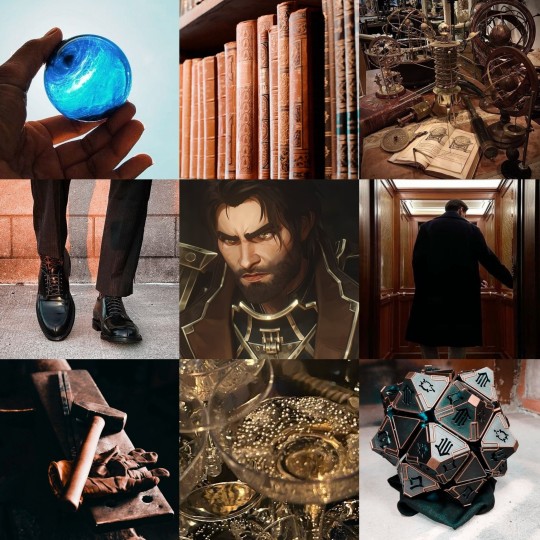
Jayce Talis, 25, Latino as far as he cares (his mom is Mexican, his father was supposedly English, he wouldn't know)
Position: Master in Experimental Physics
Raised by a single mom
The guilty money of his deadbeat dad paid for his tuition
Was not the brightest student in Elementary school but something just shifted in middle school and since then has acquired the moniker "Golden Boy" - valedictorian of his high school and bachelor program
Has crippling ADHD (on and off meds)
Is a big fan (has a crush) of Viktor's theories so he followed him around until the latter agreed to take him on as a research assistant (even pays him a bit)
Needs to create with his hands when he is overwhelmed so he found the only blacksmiths in Cambridge and works there on the weekends (loves it, sometimes Viktor or Mell will show up to encourage him or pass him a warm tea in the winter)
Is taken on extravagant vacations with Mel, whenever brands allow her to get a plus one and as a result has traveled a great deal of the world
Likes glitz and glamour just as much as he likes physics and getting dirty in the forge
Finds Sky Young and her passion for the outdoors difficult to understand but also hides in the botanic garden whenever a panic attack knocks on the door (they butt heads a lot but their hatred for a lot of other people unites them into an unstoppable force)
Doesn't get hit on a lot because everyone is scared of Mel (rightfully so)

Mel Medarda, 26, American heiress (both of her parents are American)
Position: PhD in Politics and International studies
Has a substantial online following and likes to nurture it. Wouldn't call herself an influencer but people do gawk and stare at her at campus.
Has never in her life known what it means to fail. Excels in every exam, every picture and every schedule she sets her sights on.
Picky with people, but charming to strangers
Likes to spend time in the lab with the boys whenever she has the time. Absorbs knowledge like it's nobody's business. Often offers a different perspective to their problems.
Her parents sent her off to England when she was 10 to a boarding school so she wouldn't grow too attached to them (they have never been a strong presence in her life). That built up a level of insecurity and anxiety within her that whenever they DO show up they're always disappointed she is not hanging out with those that could elevate her status.
Is close with her brother however (he is an aspiring politician). He likes all of her lovers/friends.
Due to everyone's attention always being on her, she TOO hides in the botanic garden to spend time with the human version of lily flowers. Also has a crush on Sky Young as much as Jayce has a crush on Viktor (they are excelling at bisexuality). Sky put a Marigold behind her ear once and told her everything will be alright and Mel's heart never quite recovered from that.
Also enjoys spending time just with Viktor. Jayce can be overwhelming at times. Viktor provides a slower pace and a more structured conversation. Brings him to galas where her parents have some level of involvement. He provides her with a lot of emotional support due to his DNA's idgafism.
Any attempt to hit on her falls flat. It's the equivalent of "baby...we couldn't even get a drink together."
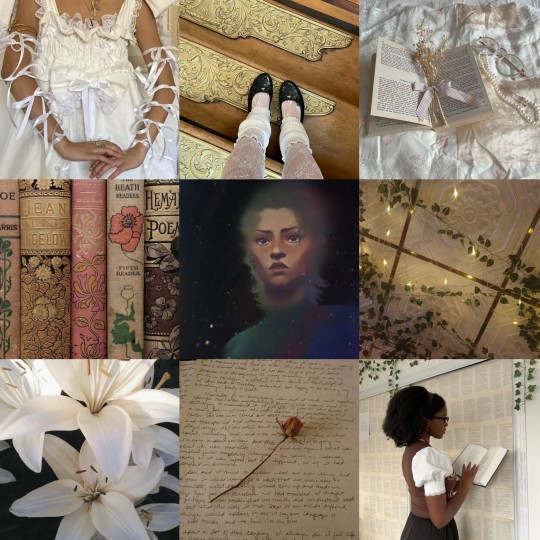
Sky Young, 25, Mixed (Eastern European mom, British dad. Her mother's genes didn't even put up a fight, they just resigned)
Position: Master in Biological Studies with a focus on Plant Science
Has a full scholarship from the university. Also chose to assists the dean of bio studies (makes good money out of it) as to not burden her parents
Sky's and Viktor's moms were close when they were young so Viktor and Sky grew up relatively close whenever Sky traveled "home" for "vacation". She'd throw stones at anyone who had something to say about Viktor's disability (she never understood how they could be so mean to someone so inspiring)
Her parents nurtured her love for anything she wants to be (she's very emotionally healthy)
A shy extrovert. Needs a minute to get going. She makes acquintances very easy and can't quite figure out when sweetness borders on flirtations with those she truly cares for. (Doesn't understand how counting the moles on your childhood friend's face while holding it, putting flowers in the hair of the most gorgeous woman and hugging someone through their dark episode, is not something anyone would do)
Assigns flowers names in the garden.
Collects old volumes of classical literature
Writes short stories in her free time and bakes from time to time (designated birthday baker)
Can't drive, always walks or takes the bus (Mel would pick her up from time to time)
The only one of the four with a proper, clean apartment (they all hang out there, she makes them keys at some point)
Gets hit on a lot (she genuinely thinks people are just being nice and polite to her because she is to them)

A/N: I actually love that Au so much, if anyone has more thoughts, I'd love to hear.
#arcane#arcane series#arcane AU#hexquad#hexquad AU#sky#sky young#sky arcane#jayce#jayce arcane#jayce talist#mel#mel medarda#mel arcane#viktor#viktor arcane#jayskymelvik
61 notes
·
View notes
Text
Lego Ninjago and Race: An Analysis for the Upcoming Live Action
I know there’s been a lot of discourse in the ninjago community since a live action movie has been announced, and there’s sure to be even more after the cast list is released. Many fans are afraid the cast will be all white, while others don’t care what race the ninja will be. Non-fans looking in from the outside might say, “Why does it matter? They’re legos, they’re yellow.” I’ve seen this argument more recently, especially revolving Arin in the soft reboot Dragons Rising.
The point of this longer post is to explain how race still exists in Ninjago despite the plastic, yellow nature of the characters, and why making the cast entirely or mostly white would be a disservice to the fans and the source material as a whole. So let’s ninja-go into this topic.
Part 1: Hair and Black-Coding
When people claim that legos don’t have race, they often claim it’s because they are yellow. However, they forget that legos still have humanoid characteristics, and one of the easiest ways to tell when a lego character is black-coded is to look at their hairpiece.
Here are some examples of hairpieces clearly meant to resemble black hair textures/hairstyles:
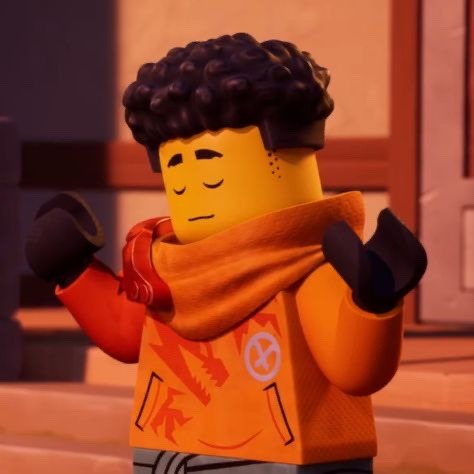



When characters have textured hair (i.e. Arin and Euphrasia from Ninjago) or locs/braids (i.e. Mateo and Zoey from Dreamzzz), it’s hard to argue they’re meant to be interpreted as anything other than black. And if that’s not obvious enough, there’s also:
Part 1b: Voice Actors and Black-Coding



People of color voice acting non-human characters doesn’t determine race, but it does add to character coding. This can be seen in characters from other shows, such as Darwin from The Amazing World of Gumball. Even though Darwin is a 2D animated goldfish, he has been voiced exclusively by black voice actors. Because of his voice (and other mannerisms/narrative elements), Darwin is generally accepted to be black-coded.
Being voiced by a person of color does not automatically make a character black-coded, but it can certainly add credence to characters who already have black characteristics, such as Arin and Euphrasia.
Part 2: Names
Another reason it’s hard for ninjago fans to interpret certain characters as white is because of their names. While many have stereotypical “American white boy names” (i.e. Jay, Cole, and Zane), other characters have names that are certainly not strictly American. Examples include Wu (a Chinese surname), Misako (a Japanese name), Chen (a Chinese surname), Okino (a Japanese surname) and Sora (Japanese given name). Ninjago may be set in a fictional world of animated, plastic people, but it’s still based on real-world names, and considering how a lot of the characters’ names come from East Asia, there is merit to declare that characters like Misako and Sora are meant to be interpreted as East Asian.
Part 3: Cultural Influences
Now, to the most obvious reason why it would be absurd to put an all-white cast on screen: the cultural influences. I am not Asian myself, but other ninjago fans have expressed frustration about the cultural melting pot that is Ninjago. It takes influence from both Eastern and Western cultures for its setting, worldbuilding, lore, and fantastical elements. Ninjago puts ninja, samurai, Kabuki, and Oni from Japanese history and culture, Djinn from Arabic regions, the yin/yang concept from Chinese philosophy, and dragons from various cultures into one narrative. There’s even a character named Ronin (which means a “wandering samurai”).
Additionally, the ninjago language seems to be inspired by Tategaki, an East Asian style of writing.
What this means is that Ninjago is brimming with real-life cultural influences. They rarely come from the same places and are not always faithful or accurate. In fact, they can sometimes seem borderline disrespectful and stereotypical in the earlier seasons- particularly with the portrayal of Chen and pilot Wu. However, it doesn’t take a genius to spot the East Asian cultural influences on ninjago. This is clear in the character designs, attire, and especially in the settings:



Part 4: What does this mean?
In summary, Ninjago is a fictional setting that takes inspiration from East Asian cultures, and has coded certain characters as certain races through more indirect means such as naming and designs. Even though none of the ninjago characters have 100% canon races, there is still evidence that some are meant to be interpreted as black or Asian. Therefore, making all the ninjago characters white would be a disservice to the fans AND the source material because it takes away subtle but essential parts of the characters and world.
Additionally: Representation matters. It could mean a lot for fans new and old to see the ninja becoming humanized and seeing themselves on screen. Not only would an all-white cast be unfaithful to the source material, but it would be disheartening to fans hoping for racial representation, especially in an age where “wokeness” is considered a touchy subject in some areas.
Part 5: Other Thoughts/Clarifications
The beautiful thing about Ninjago is that the Lego nature of the characters allows them to be interpreted in so many ways. The characters don’t have canon skin tones, eye color, body types, ages, heights, etc., so they can be whatever fans want. Whatever the fans interpret them to be or even what they feel like, they can be. And I think that’s beautiful.
TLDR: I don’t want the movie casting to limit the fan’s creativity or headcanons. Even if the cast isn’t entirely white, I hope people continue to make creations with their own interpretations of the characters.
Also: I urge fans to not harass the actors if they are white. I feel like the ninjago fandom is above that but I feel inclined to make this statement in advance regardless.
Finally: I’m leaving this post wide-open to discussion and discourse. I did surface-level research for the ninjago cultural influences, so if anyone wants to add on to or correct anything, feel free to do so. All I ask is that the conversations remain civil.
That is all :)
#ninjago#long post#ninjago live action#cole brookstone#jay walker#zane julien#lloyd garmadon#nya jiang smith#kai jiang smith#master Wu#Misako#essay#kinda#discourse#idk what else to tag#yapping a little#analysis#ninjago analysis#dragons rising#arin ninjago#sora ninjago#Lego ninjago#ninjago euphrasia#Lego dreamzzz#misako ninjago
81 notes
·
View notes
Photo

Education in Roman Spain
There was no compulsory state education for children in any of the western provinces of the Roman Empire. The primary sources are sparse when it comes to the education in Roman Spain, and while some scholars argue for a network of schools, others suggest that in the remoter areas of Spain sourcing Latin and Greek speaking teachers may have been difficult, and Roman education had geographical limitations.
Teachers in Roman Spain
In 197 BCE, the Roman Republic divided the peninsula into Hispania Citerior (near) and Hispania Ulterior (far). In 27 BCE, Marcus Agrippa further divided the Ulterior region into Baetica (the modern-day Andalusia area) and Lusitania (the area of western Spain & part of modern-day Portugal).
Our sources indicate that Roman educational influence in these provinces was expanding sufficiently to require the services of teachers. The homogeneity in the style and content of education in the whole of the Roman Empire was striking; the same methods were used, and the same texts were worked on everywhere. Teaching was seen as a humble position; the average teacher was a man of lower social status who worked independently and had to maintain himself in a schooling system without any support from the Roman government. He worked for a low income, with which he had to also provide a teaching space, whether it was outdoors or beneath shelters or in hired rooms.
Inscriptions provide us with the evidence of the presence of the three principal categories of Roman educators:
The magister or litterator provided an elementary Roman education for girls and boys aged 7-11 years old, which included reading, writing, mathematics, and languages.
The grammaticus worked with boys aged 11-15 years old (in accordance with the role of women in the Roman world, girls generally finished their formal education at this age), teaching subjects such as Greek and Roman literature and philosophy and developing their writing, speech, and language skills.
The rhetor trained students in subjects including public speaking, Roman law and politics; education at this level was only affordable for the upper classes, and it prepared a young boy for his future career and position in the higher echelons of Roman society.
Inscriptions confirm that in Baetica and Tarraconensis and other areas in the eastern and southern coasts of Hispania, children were learning with a grammaticus (CIL II. 5079). Roman studies for boys sometimes also continued with the rhetor.
Read More
⇒ Education in Roman Spain
35 notes
·
View notes
Text
Vedic Astrology Observations
Moon Dominant Men: “Deep and Mysterious”
🌖🌗🌘🌑🌒🌓🌔

(GIF context: Taken from Shadowhunters depicting a gay couple with Matt Daddario (left) who is Moon Dominant [Hasta sun and ketu with ketu as moon nakshatra ruler] and Harry Shum Jr. (right) who is Rahu Dominant [Ardra moon and Swati Jupiter with Sun in Jupiter ruled nakshatra]. Both actors identify as straight.)
In Vedic astrology, the Moon, or “Chandra”, occupies a position of profound significance. It is coveted as the very embodiment of the mind, a symbol resonant with clarity, reflection, instincts, and cycles, which when combined come to form what we know as perceptual consciousness. Like the Moon, which shines by reflecting the Sun's light, the mind similarly reflects its environment. It captures and reinterprets external stimuli, forming a consciousness that is, in essence, an image similar to that of a mirror of the surrounding world. In Vedic astrology, the Moon is a celestial body that stands as the fundamental indicator of one’s capacity for emotion and extends to one’s ability of cogitation, shaping the manner in which thoughts and emotions are processed and articulated. In contrast to Western philosophical perspectives, which tend to dichotomize emotions and logic, framing them as diametric to one another, Vedic astrology presents the Moon as a mediator that brings the two faculties together through upholding the position that our cognitive and decision-making processes are inextricably linked with emotional undercurrents. It echoes a sentiment that, even in endeavors that ostensibly try to prioritize objectivity, such as with epistemological pursuits, true objective knowledge is nothing but an elusive ideal. This stems from the notion that our perception forms our reality, encapsulated in the phrase, “I am my universe.” This is where the significance of the Moon in Vedic astrology becomes particularly relevant. It posits the idea that our subconscious greatly influences our conscious mind, thereby molding our individual perceptions of reality and shaping the way we experience the world. It recognizes the limitations in our control over our mental faculties and how emotions actively play a part in deciding our thoughts and life trajectories, whether we like it or not. This allows the symbolism of the Moon in Vedic astrology to effectively capture the human condition's amalgamation of thought and feeling, thereby speaking to the interaction of light and shadow in the psyche and the ongoing process of mental transformation.
Men with a pronounced lunar influence in their astrological charts, notably distinguished by those with primary placements (Sun, Moon, or Ascendant) in or aspects with Moon-ruled nakshatras such as Rohini, Hasta, and Shravana (planetary dominance can be determined in more subtle ways as well), present an intriguing study into the nuanced expressions of masculinity and relational dynamics. Examples of Public figures like Henry Cavill, with his Shravana Ascendant and Moon in the first house, or fictional characters like Flynn Ryder, voiced by an actor with a Hasta Sun and Rohini Moon, exemplify a unique blend of characteristics associated with lunar dominance that I will continue to explore further.
(GIF and image contexts: The first GIF shown depicts Henry Cavill as Clark Kent in Man of Steel. The second is an image showing the fictional character Flynn Ryder side by side with his voice actor Zachary Levi.)


The influence of the Moon on men can be understood through the influence of the mother and the lens of "Yin and Yang" in Eastern philosophy. In Vedic astrology, the Moon's connection with the mother can be said to link the development and characteristics of individuals to the amount of nurture and emotional sustenance they were provided with as a child. This nurturing shapes the robusticity of their intrinsic Yin qualities – receptivity, passivity, intuition, and a deep connection with the maternal aspects of life, often linked to the feminine. These qualities are further symbolized by the Moon and its cycles, traditionally associated with menstruation, highlighting the cyclical and nurturing features of femininity. In contrast, Yang represents the dynamic, assertive, and outward energy projection, typically linked to the masculine and more solar sattvic energies. Men with Moon-dominance in their astrological profiles embody this Yin energy, exemplifying a reflective masculinity and an inward understanding of femininity. This inward orientation of Yin, shaped significantly by the emotional and nurturing bond with mother figures, provides these men with a deeper understanding and connection to various feminine aspects of life. At the same time, the outward orientation of Yang allows for an external connection to the masculine, producing a self-identified masculinity that is introspective and emotionally/mentally attuned to the feminine while still being confident in its own nature. This ultimately does have a dampening effect on their exhibition of traditionally masculine behaviors, being that men as a whole are ruled by the Sun and are said to be more solar, while women as a whole are ruled by the Moon and are said to be more lunar. (The 24-hour circadian rhythm is based on the male hormone cycle and aligns with the Earth's orbit relative to the sun, while women have what is known as an infradian rhythm, which follows the 28-day lunar cycle, for reference). This internal emphasis on Yin but external reflection of Yang in Moon-dominant men's personalities makes them emotionally rich and empathetic, displaying a unique blend of masculine and feminine energies that is both introspective and in harmony with the external world. The Moon serves to harmonize the intense energy of the Sun, offering calming and nurturing attributes, ultimately leading to the formation of a kind of masculinity in these men that is fluid and can express strength in gentleness and assertiveness in sensitivity. However, this can also make them uniquely susceptible to certain challenges, which I will continue to discuss further in the following paragraphs.
The Moon is also tied with its nodes: Rahu and Ketu, the two mathematical points where the Moon's orbit meets the ecliptic (if you didn’t know, the Moon does not directly follow the ecliptic itself, which is the sun's path in the sky; it’s about 5° off approaching either node). The Moon's astrological significance is intricately linked to Rahu and Ketu, with all three governing distinct facets of consciousness. Rahu, often depicted as the head of a dragon or the head without a body, symbolizes material desires and is associated with the future, representing the qualities we need to develop and the experiences we must have to grow. Rahu is primarily concerned with the rational mind and the projection of consciousness into the material realm, epitomizing ambition, desire, and worldly aspirations. It represents the part of the psyche that is outwardly focused, engaging with the tangible aspects of life that are said to paradoxically represent the illusion of Maya. Conversely, Ketu, commonly depicted as the dragon’s tail or a headless body, represents detachment, spirituality, and the internal journey. It is associated with the past and karmic baggage, indicating the lessons we have learned and the experiences we must release to evolve through Samsara to achieve Moksha. Ketu is about letting go and achieving spiritual enlightenment. It is associated with intense spirituality, introspection, and the aspects of the psyche that delve into the depths of the subconscious and the ineffable. Ketu represents the part of the mind that seeks to understand and connect with the intangible, the mystical, and the existential. (In Vedic mythology, Rahu and Ketu are said to be the same demon killed by Vishnu)
The Moon acts as a mediating conduit between these two nodes, attempting to balance the rational, materialistic impulses of Rahu with the spiritual, introspective tendencies of Ketu. It symbolizes the emotional and perceptual aspects of consciousness, playing a supreme role in how feelings and intuition are integrated with rational thought and spiritual insight. The Moon's position in a chart thus reflects the ongoing dance between the material and spiritual dimensions of human existence, influencing how individuals perceive and interact with the world around them. And because the moon works with the energy of both nodes, we can gain knowledge into the expression of Moon-dominant individuals by looking at aspects of Rahu-dominant and Ketu-dominant natives.
Rahu-dominant men often exhibit a desire for control, particularly in their mental environments. Their creativity often manifests in unique, sometimes eccentric ways, setting them apart in their expression and thought processes. These individuals typically lean towards liberal ideologies, embracing progressive and forward-thinking concepts but is often against society as a whole. Rahu-dominant men are often driven by ambition and a desire to achieve success and recognition. They are inclined to be more outwardly assertive in their quest for control, sometimes pursuing their goals with a relentless, almost aggressive, determination. This pursuit often leads them to challenge established norms and push boundaries, both socially and professionally. And while Moon-dominant men share traits with Rahu-dominant men, they exhibit distinct differences in how these characteristics are expressed and integrated into their personalities. Moon-dominant men tend to internalize their need for control, focusing more on emotional and psychological self-mastery. They are more concerned with understanding and regulating emotions rather than exerting control over external circumstances for the sake of gaining power, and they are more satiated with what they have rather than desiring what they don't, making them less materially-orirented than Rahu. Rahu men often have an obsession with external appearances and how others perceive them, trying to enforce their own rules or standards on others in order to gain the upper hand, but Moon men just want to maintain their own sense of security. They may still try to subtly reshape situations though, not to become the dominant power, but as a means to maintain their personal well-being, even at times to the detriment to others. Additionally, their approach to creativity is more reflective and introspective than what you might expect to see from Rahu, often drawing from deep emotional reservoirs and personal memories. Moon-dominant men may too challenge conventional thinking like Rahu dominant men, but their methods are typically more subtle and under the radar. For example, if a Moon-dominant man wants to avoid an arranged marriage, he might subtly express concerns or sadness about the marriage in a manner that is meant to gently persuade his family to rethink their decision. Simultaneously, he might engage in covert actions to disrupt the arrangement, such as discreetly creating scheduling conflicts and other minor obstacles that prevent it from happening efficiently as if to send unconscious signals that it was not "meant to be." In more extreme instances, he may feign agreement, choosing instead to engage in extramarital affairs, all while maintaining a cloak of compliance to avoid direct confrontation. This is in stark contrast to a Rahu man who will openly question and criticize the tradition, speaking out against his family to say it is stupid, and he may even actively rebel against it by running away to marry someone else.
(Add-on: both Rahu and Moon men possess an acute awareness of the perils of straying too far from rationality and thus are inclined to maintain a strong connection with external reality. They may encounter challenges when they engage too much with the immaterial, like dreaming, drugs, alcohol, gambling, etc., leading to their connection with external reality becoming tenuous. This disconnection can lead to issues such as escapism, addiction, and emotional disturbances, so be wary and try not to get to the point of obsession where you lose sight of your life.)
Conversely, Ketu-dominant men often possess a deep internal focus and an inclination towards introspection. Ketu-dominant men are often characterized by their profound spiritual orientation and a tendency towards seeking inner peace and enlightenment. They may exhibit a strong interest in the metaphysical or the mystical, delving into areas that transcend the material world. This spiritual pursuit often leads them to detach from worldly ambitions and superficial desires, making them appear aloof or disinterested in material success, paradoxically leading them to attract immense power. They tend to absorb energy from their surroundings, revealing truths in impactful ways and arousing servitude in others due to their stilled, void-like nature that makes people want to give to these men tirelessly. Ketu-dominant men might display a more pronounced detachment from their emotions. While they are capable of deep feeling, they often approach their emotions from a place of observation and analysis, rather than immersion. This detachment can sometimes be misinterpreted as coldness or indifference, but it is more accurately a sign of their deep internal processing and preference for solitude. Moon-dominant men, while sharing certain introspective and internal qualities with Ketu-dominant individuals, exhibit these traits in distinctly different ways, shaped by the unique lunar influence. while Moon-dominant individuals also exhibit introspection and depth, their focus is more on the emotional and psychological features. They are keenly attuned to the nuances of their own emotions as well as those of others, and this emotional sensitivity often translates into a strong sense of empathy and an intuitive understanding of human nature. Unlike the Ketu-dominant detachment, Moon-dominant men are more engaged with their immediate environment, forming deep emotional connections and valuing interpersonal relationships more than Ketu men (note that this also depends on the placement of moon in the chart as a whole, like 12 house Moon in Jyeshtha will be more Ketu-like for example). Moreover, Moon-dominant individuals may exhibit a fluctuating nature, akin to the waxing and waning phases of the Moon. They can be adaptable and receptive, often reflecting the energies around them, which can lead to a rich, albeit sometimes confusing, emotional life. This contrasts with the more consistent, inward-focused nature of Ketu-dominant men, who may remain unfazed by external circumstances, steadfast in their introspective approach for better or worse. People are drawn to both Moon and Ketu dominant men due to their compelling allure of hiddenness, but unlike the Ketu man that will remain still and almost hollow, absorbing all of the energy and power they come in contact with through their tamasic nature, Moon men will reflect energy back. This reflection of energy, softer and more reciprocal, differentiates Moon-dominant men from their Ketu-dominant counterparts, in the way that it doesn’t illicit as much discomfort in others. What usually happens with Ketu men is that others sense their inherent “emptiness,” which causes them dis-ease to the point where they will shower these men with energy in hopes that doing so will change the Ketu man or stabilize him. But Ketu men don’t work like that; their purpose is to take and consume, so no matter how much energy people give them, it is never going to be enough to make that penetrating uneasiness they give off go away. This isn’t a bad thing though. In fact, it is beneficial to the energies whose purpose it is to give, like Jupiter. It just comes down to the role people are meant to serve in this life. The differences between Moon and Ketu men highlight the unique ways in which they connect with and respond to the world around them as it relates to their Dharma.
Connecting Rahu and Ketu, because of the Moon’s relationship with both of these astrological energies, Moon-dominant natives will not only resonate with the powerful spiritual and subconscious layers of Ketu, but also to the more tangible, worldly, and reasoned aspirations represented by Rahu. This connection with Rahu and Ketu instills Moon-dominant men with a magnetic charm, characteristic of Ketu men, that is less domineering and still grounded in the more rational world of Rahu, making their allure more accessible and relatable to others. Unlike the piercing, sometimes overwhelming and obsessive depth of Ketu and the overbearing frigidity and judgments associated with Rahu, the Moon's influence results in more of a balanced persuasive appeal, empowering them with an immensely vitalizing aura. Overall, while there is a resemblance between the effects of Rahu/Ketu and the Moon, the way they manifest and are perceived is distinct. I think it bears mentioning that since the Moon deals with the energies of both, its natives are also susceptible to accompanying pitfalls for either. Because despite their inter-relation, the Moon’s integration of these energies can be messy. Rahu and Ketu are the extremes, which can end up eclipsing the Moon and/or the Sun, “swallowing” their energies (light) to try and destroy them. This solidifies the nodes’ place as natural adversaries of the luminaries.
(Add-on: There’s a balance that must be struck when dealing with these energies, and sometimes they can just be too difficult to manage, leading to things like insanity. While the Moon, Rahu, and Ketu are similar, it is important to remember the differences, with the main takeaway being to exercise awareness and moderation, as these energies can be seriously harmful when experienced in excess. Intriguingly, individuals under the influence of the Moon, Rahu, or Ketu bodies often show the most fascination with understanding psychology, perhaps drawn to explore the very forces that make them uniquely susceptible to emotional and mental turbulence. And oh… isn’t that poetic?)
Alright, now let’s get into the juice of things. As alluded to before, men whose astrological charts are heavily influenced by the moon have the ability to understand emotions and empathize deeply with the feelings of those around them, allowing them to form powerful connections within their relationships. Their insight into the human mind and “heart,” much like the Moon's light that gently illuminates the night, shines on the more hidden aspects of those they interact with. They are known for their exceptional depth of emotional acuity as well as having an intuitive grasp of mental states, including their own. This is typically not overt, however, since there is a concealed nature to the Moon, being traditionally associated with obscurity and subtle aspects of the human psyche. In addition to this, since men perceived as being outwardly feminine have historically been subjects of abuse and harsh treatment from society, Moon-dominant men are more inclined to sheath the less hardened parts of themselves for fear of social scorn. This is important to keep in mind, since Shravana is the most refined and mature expression of the Moon.
Symbolized by an ear, this nakshatra signifies listening, learning, and connection. It is associated with the acquisition of knowledge and the understanding of the world. Men influenced by Shravana may possess a strong inclination towards gathering information, being attentive listeners, and showing a deep interest in the narratives and experiences of others. This attentive and perceptive nature is a personification of the Moon's influence, producing qualities like empathy and understanding, which can be seen as more feminine in nature. Being in Capricorn (the natural ruler of house ten: career and reputation), it is also deeply entwined with themes of reputation and public perception in addition to control. This comes into focus when we consider how Vishnu, the Deity ruling over Shravana for men, is the preserver, suggesting a proclivity of these men to maintain their public reputations and personas through discipline (Saturn deals with control and discipline and is the ruler of Capricorn, for reference). Interestingly, I’ve noticed that Rohini and Hasta men tend to be more openly receptive than Shravana. Hasta is a nakshatra that is linked with dexterity and skill, symbolized by a hand, and more specifically with the ability to manifest one’s desires into the hand. The influence of its ruling deity Savitar, an incarnation of the Sun (contradictory, I know), gives Hasta characteristics of vigor, intelligence, and the ability to dispel ignorance. However, this solar influence is juxtaposed with the Moon's governance over Hasta, which brings in a more calculative desire for energy exchange through things like conversations, meetings, sex, negotiations, fighting, etc., which is not carried out in quite the same way as Sun-dominant men, being that the Moon introduces a more emotionally intelligent approach to these interactions. While the Sun's influence might drive a person towards externally focused actions where they expend energy carelessly, the Moon's guidance in Hasta gives a deeper sensitivity and awareness in their engagements. This means that their approach to energy exchanges, whether in professional settings, personal relationships, or even in conflict, tends to be more reflective and considerate of the emotional context. Men influenced by Hasta may exhibit a strong, vibrant persona, often marked by a commanding yet undeniably soft presence (I’ll reference him again, but the best example of this I could find is Leonardo DiCaprio who is Hasta Moon and Ascendant). Rohini, the first nakshatra under the dominion of the Moon and co-ruled by Venus in Taurus, is emblematic of the chariot, an ancient symbol related with themes of progress, movement, and evolution. This nakshatra's associations with growth, creation, and fertility find their roots in the nurturing energies of the Moon, where it is in exaltation, and the artistic, sensual qualities of Venus. The deity overseeing Rohini, Brahma, is revered as the creator in the Hindu pantheon, further intensifying the nakshatra's intrinsic connection to creativity, nurture, the enjoyment of creation, and the genesis of life. Rohini men often exude natural charm, emphasized by a creative and nurturing disposition. These qualities, resonating with the creative and generative aspects of Brahma, can be seen as more feminine in nature. However, due to societal pressures to adhere to traditional masculine norms, Rohini men might feel compelled to mask these traits. The pressure to conform to traditional masculine norms might lead Rohini men to stifle or conceal these aspects of their personalities, as I've come to acknowledge can be a facet of all Moon men.
The Moon's dominance in a man's chart can influence his expression of gender and identity, modulated by whether he is accepting of his femininity, as observed in public figures like David Bowie (Shravana asc. and Rohini rahu), Prince (Rohini sun and mercury), Troye Sivan (Rohini sun and mercury), etc. These men, embracing their lunar qualities, often work to defy traditional gender norms, adopting androgynous styles that symbolize the fluidity of their gender identity. Their choices in fashion - long, flowing hairstyles, delicate fabrics, and makeup or nail polish - are external manifestations of their inner lunar essence. Some even go as far as dressing up like women! It is not done in a castigating manner where they make fun of the idea as a form of humiliation either; rather, it is more of an attempt to make a full embrace of what it would be like to genuinely exist as a woman, albeit a tad bit over-exaggerated in terms of femininity, but to be fair, that’s the same for Moon-dominant women as well. (This is a bit of a tangent, so skip if you aren't interested. Interestingly I think these men’s personas of women are closer to Ashlesha [in cancer rashi ruled by moon but nakshatra ruler Mercury] than of Moon nakshatra women, possibly being a result of these men having so much pent up female sexuality that yearns to be dominated in much the same way as Ashlesha women, who act outwardly dominant to test the virality of others – beckoning to be overpowered. I noticed this in the new movie Expendables, which stars Jason Statham and Megan Fox (Ashlesha moon). In one scene, they are fighting and Megan Fox comes out on top before again being overpowered, demonstrating that the man is virile enough to "have"/contain/satisfy her. And then she redirects his penetrative energy yet again, which is a common theme of Ashlesha. The "cutesy" fake innocence at the beginning is also something Ashlesha women are known for.)
(GIF context: It shows Troye Sivan dressed in drag for his latest music video and song "One of Your Girls". He is also openly gay and for the time being has not declared he is trans, nonbinary, etc. For fun, you can compare that with this music video with Megan Fox, who is an Ashlesha woman to see what I mean when I compare them: video.)

However, most Moon-dominant men are not as comfortable expressing this duality so openly. Many, in response to societal pressures that valorize hyper-masculine traits and often stigmatize femininity in men, adopt a façade of heightened contentment, stoicism, and control. This outward show, mirroring the characteristics of Sun and Saturn-dominant men, is an attempt to conceal their innate Yin nature. Yet, akin to the Moon which only reflects the Sun's light in a softer, cooler manner, their portrayal of hyper-masculine traits is not pure or without cracks. People can still very much pick up on their the fact that they are simply reflecting masculinity while still internally housing receptive feminine energies, since they reveal themselves in small but noticeable ways that make them stand out from other men. They usually carry with them an undercurrent of mystery, farce, and a general tendency to be overly, and dare I say even comically, brutish, while their emotionally expressive nature still peeks through. This divergence from the archetype they emulate within imparts an illusory, intriguing energy to their persona, attracting some while aggravating others who are less willing to accept the illusion. The struggle to mask their true nature often leads to complex interpretations of these men. It reflects the multifaceted nature of the Moon, continuously oscillating between visibility and concealment, constantly changing from clarity to mystery. This theater play of lunar influence in their lives makes these men seem as though they are impossible to understand fully, impressing, confusing, perplexing, and captivating all who come across them.
Celebrities like Theo James (Hasta moon and Shravana venus), Christian Bale (Shravana sun), Noah Centineo (Shravana moon and ketu), Joe Jonas (Shravana moon and Hasta asc.), etc. find their sexuality and morality subject to speculation and even denial by the general public. This scrutiny mimics the way women are often doubted and judged, suggesting a societal judgement of the feminine nature. The public's perception and scrutiny of the sexuality and morality of these men often reaches a point where rumors and allegations, ranging from them secretly being gay or abusive, become rampant. This perceived incongruence between their public persona and private self can trigger a sense of being "lied to" in observers, leading to a backlash or a desire to uncover the 'truth' about these men. The Moon's influence, thus, extends beyond the individual to affect public perceptions and reactions in this way. This phenomenon also offers insight into why Moon-dominant male celebrities (in addition to Rahu and Ketu-dominant men, I’ve noticed) often find themselves cast in roles as gay characters, even while being openly straight, such as in the case of Jake Gyllenhaal (Rohini moon, Hasta jupiter and saturn, and Shravana ketu [his second dominant]) in "Brokeback Mountain,” Harry Styles (Hasta moon & Shravana sun and venus) in “My Policeman,” Ewan Mcgregor (Hasta asc. and cancer rashi ketu in Ashlesha) in “The Pillow Book,” Nick Robinson (Hasta sun) in “Love, Simon,” the examples I gave in the caption at the very beginning for Shadowhunter, etc.
(GIF contexts: The first GIF shows Theo James in the TV series "Sanditon" as Sidney Parker giving a cheekish smile. The second shows Harry Styles in "My Policeman" getting his neck kissed by his male lover while he smiles with enjoyment.)


The Moon's association with fluidity, hidden depths, and possessing understanding of emotions and identity makes these actors particularly adept at portraying complex, non-traditional roles (they are great at portraying emotions at all levels of intensity in general, with a prime example being Leonardo DiCaprio [Hasta moon and Asc. moon in 1st house]), who is known to be a phenomenal actor, almost shapeshifting into whatever a movie expects of him and displaying deep, powerful emotions). However, that being the case, Ketu and Rahu might still be more prominent when it comes to this trope of casting straight men to play gay roles, possibly due to homosexuality often being seen merely as the act of having sex with other men, rather than an intimately personal aspect of identity that has an impact on all areas of an individual’s life. This has the effect of reducing gay characters to straight men more willing to engage with ideas seen as non-conventional or morally perverse (more commonly associated with Rahu and Ketu), while still maintaining their straight charm that appeals to mainstream audiences. It is easier to depict gay men as "devouring" or Ketu-like, as seen in associations with Mula Nakshatra, which is related to the act of excretion from the anus, but this narrow depiction overlooks the complexity of sexual orientation, reducing it to pure physicality of external behavior. It fails to acknowledge that being gay encompasses a broad array of emotions, experiences, and identities far beyond superficial characteristics. Moon-dominant mens’ ability to resonate with and express a wide spectrum of human experiences, including those that challenge conventional norms, is enhanced by their lunar characteristics, but these themes might also be more prone to attracting false representation due to widespread misunderstandings. I’d also like to make it known that I am aware that there are many gay and bi Moon, Rahu, and Ketu-dominant men as well; they just aren’t nearly as common and hardly, if ever, get casted in the kind of deeper gay roles I'm referring to.
Continuing this exploration, it's evident that the very qualities that lend Moon-dominant men their depth, intrigue, and warmth can also lead to significant challenges. The Moon's inherent receptivity endows these individuals with a remarkable adaptability, which, while often a strength, can manifest in less positive avenues. Their exceptional ability to influence perceptions and beliefs, a direct result of their emotional responsiveness and innate understanding of the mind's energies, can become problematic. In certain circumstances, this lunar influence may veer into darker territories with one major potential downside in particular being emotional manipulation, where their intuitive grasp of human emotions can be misused for personal gain or to sway others unduly. Their innate power over emotion and human psychology can lead them to engage in behaviors such as lying, espionage, cheating/betrayal, infidelity, illegal clandestine activities, and exploitation. The Moon's association with hidden aspects and the subconscious mind makes its natives highly skilled at navigating these activities, sometimes even leading them into antisocial or unethical paths, which can be seen in many different media portrayals I’ll cover later on. But for now, I will point to the personal life example of Ryan Philippe (Shravana asc. & Hasta mercury), who is notorious for his multiple instances of cheating on his wife and other subsequent partners, in addition to a history of drug misuse and allegations of domestic violence. An important thing to note when I speak about these things, however, is that while they can be masters of manipulation, Moon-nakshatra men do not possess complete control over the mind to the point where they always get people to do anything they want. Similar to the Moon relying on the Sun's light, their "power" actually depends on people willing to project onto and exchange energy with them, which can make Moon-dominant men extremely vulnerable, even more so than Moon women (people will instinctually try to defend moon women because they perceive them as being pure and innocent, unable to protect themselves; the same sentiment is not afforded to Moon men, who people think should be able to defend themselves with their physical power). In fact, Moon-dominant men often struggle to set boundaries due to a fear of direct confrontation as well as a desire to be what other people want of them, often worshipping the people they are closest to (they really want respect and attention from others and will endure harsh treatment or act untoward if it means getting that from someone they respect themselves, sometimes to an unhealthy extreme). That brings me to my next point of abuse... Whether inflicted or incurred, abuse (especially relating to domesticity and women) is another shadowy aspect of the Moon's influence in Vedic astrology, aligning with many of the experiences of Moon-dominant men in media and in real life. The frequent association of moon-dominant men with themes of abuse in media – be it as perpetrators, victims, or both – intertwines notions of vulnerability and aggression, showing the darker side that emotions can take, and subsequently, the darker side humanity can take as well. Overall, it makes sense why people often connect Moon men to ideas of abuse in media and in real life, such as with Evan Peters (Hasta moon and Shravana mercury) in “American Horror Story—Coven” where he was sexually abused by his mother (among other things; that show put him through it...), Christian Bale (Shravana sun) in American Psycho being abusive towards women, Tom Hardy (Hasta moon and Rahu) in “Peaky Blinders” being extremely violent and hedonistic, etc.
(Add-on: This is a bit of sensitive topic related to sexualization, so discretion is advised. Just as women traditionally face sexual objectification, Moon-dominant men may also encounter similar treatment due to their inherent passivity and receptive nature, leading to sexualization and other forms of scrutiny that stem from societal tendencies to view individuals who are more passive and receptive as feminine as being more accessible to take advantage of. This sexualization, particularly prevalent in the portrayal of these men in scenes of nudity [I've yet to find a Moon-dominant male actor who has not done a nude scene, even though many speak about how they did not want to do it at the time and felt uncomfortable] or in the adult film industry (an industry known for its connections with abuse) where I've found Moon men to be most over-represented in terms of planetary dominance, showcases a societal inclination to exploit those exhibiting traits diverging from traditional assertiveness.)
(GIF contexts: The first GIF shows Evan Peters in American Horror Story Crying. The second GIF is of Tom Hardy in Peaky Blinders smoking.)


In the film industry, the energies of Moon-dominant men, characterized by their complex emotions, adaptability, and concealed depths, are astutely recognized by directors. This insight informs casting decisions, often placing Moon-dominant actors in roles that mirror the multifaceted nature inherent in them. Christian Bale's (Shravana sun) portrayal of Jim Luther in "Harsh Times" exemplifies this, exploring the darker recesses of the human psyche, a reflection of the Moon's association with concealed motives and intricate emotional situations. Similarly, Denzel Washington's (Shravana moon, Hasta asc.) performances in "American Gangster" and "Training Day" depict a tough exterior masking a softer core, Michele Morrone (Hasta sun & venus and Shravana rahu) in "365 Days" intertwines criminal elements with deep emotional entanglement, and Tom Hiddleston's (this one is super interesting because, while he doesn't have any primary moon placements, he does have Hasta jupiter & saturn— the moon nakshatra ruler and subruler of his chart plus Shravana Venus and ketu, so I consider him moon-dominant) Loki across Marvel films embodies cunning coupled with hidden vulnerability. Matt Daddario (see top of post) and Matt Bomer (Hasta moon, mercury, and rahu), in "Shadowhunters" and "White Collar" respectively, delve into the realms of a secret society of demon hunting & then crime/subterfuge with personal attachments to it, personifying the Moon's nature.
(GIF contexts: The first GIF shows Michele Morrone in 365 days shirtless and talking while looking down. The second GIF is taken from White Collar showing Matt Bomer talking frantically.)


Zachary Levi as Flynn Ryder personifies this duality - mischievous yet sensitive, conniving yet protective, masculine yet feminine, seeking introspective depth yet maintaining material asperations, and so on. Followed by Henry Cavill's roles, particularly Superman and Geralt, further illustrate this theme of his invincible, hyper-masculine superhero persona of Superman veiling the sensitive, complex nature of Clark Kent that he must keep hidden through great discipline (The original actor for Superman Kirk Alyn was also moon dominant (Hasta sun and mars with a lot of his chart's energy tracing back to sun). One the other hand, Christoper Reeve– arguably one of the most popular actors to play Superman– has his Sun and Mercury less than one degree away from being in Hasta, but overall, his chart is still Sun-dominated with a lot of Uttara Phalguni and Krikita, which makes sense because one: it was old hollywood, and two: the reason people love him is for his portrayal as the hyper-masculine persona of Superman, which would have been closer to Reeve's true nature anyway. In my opinion, his portrayal as Clark Kent is kind of bad because he treats that like it is supposed to be his geeky alter-ego rather than the fact that he would have been raised as Clark Kent– the humble farm boy from Kansas, not as Superman. Anyway, rant over). And Geralt, who presents a facade of absolute masculine strength defeating monsters for a living and projecting a sense of detachment from others, all while concealing a deeper, more nurturing and intimate side of himself. These portrayals, necessitating depth and often grappling with themes of manipulation and other complex moral dynamics, go hand-in-hand with the Moon's influence on hidden emotional strata and ethical complexities. The performances of these actors align with the experiences of many Moon-dominant men, reflecting the nature of their personalities. (Thank you so much to anyone who read this entire thing! 🙂 I know it’s a ton of information to get through, so I do really appreciate any time and effort people put into reading this!)
#vedic astrology#astrology#astrology observations#nakshatras#zodiac#astro community#astro notes#astro observations#zodiac signs#astrology notes#vedic chart#vedic astro observations#vedic astro notes#vedic texts#vedic mythology#lagna#astro placements#astroblr#sidereal astrology#capricorn#virgo#taurus#moon men#moon-dominant men
216 notes
·
View notes